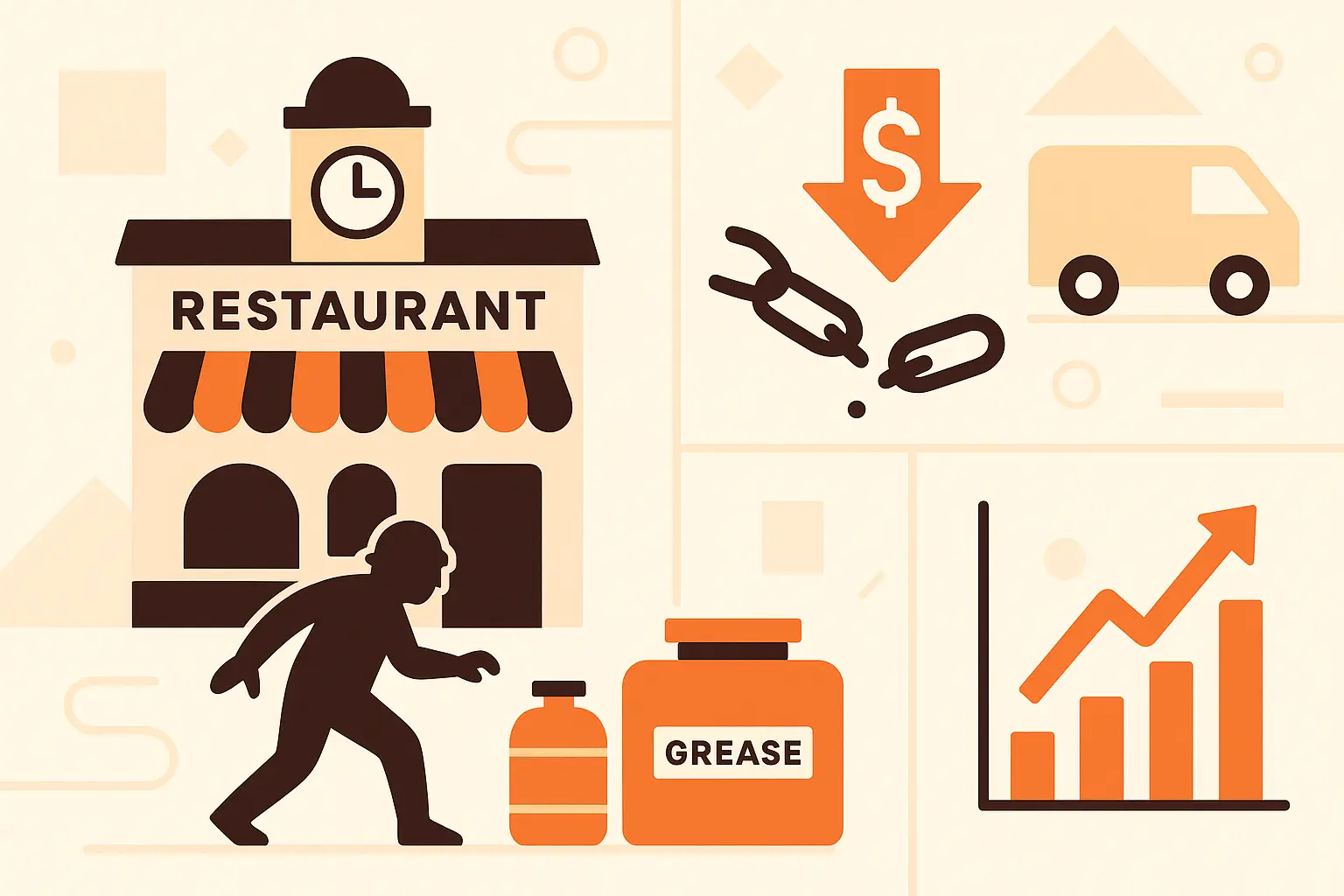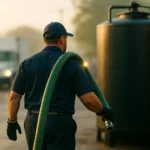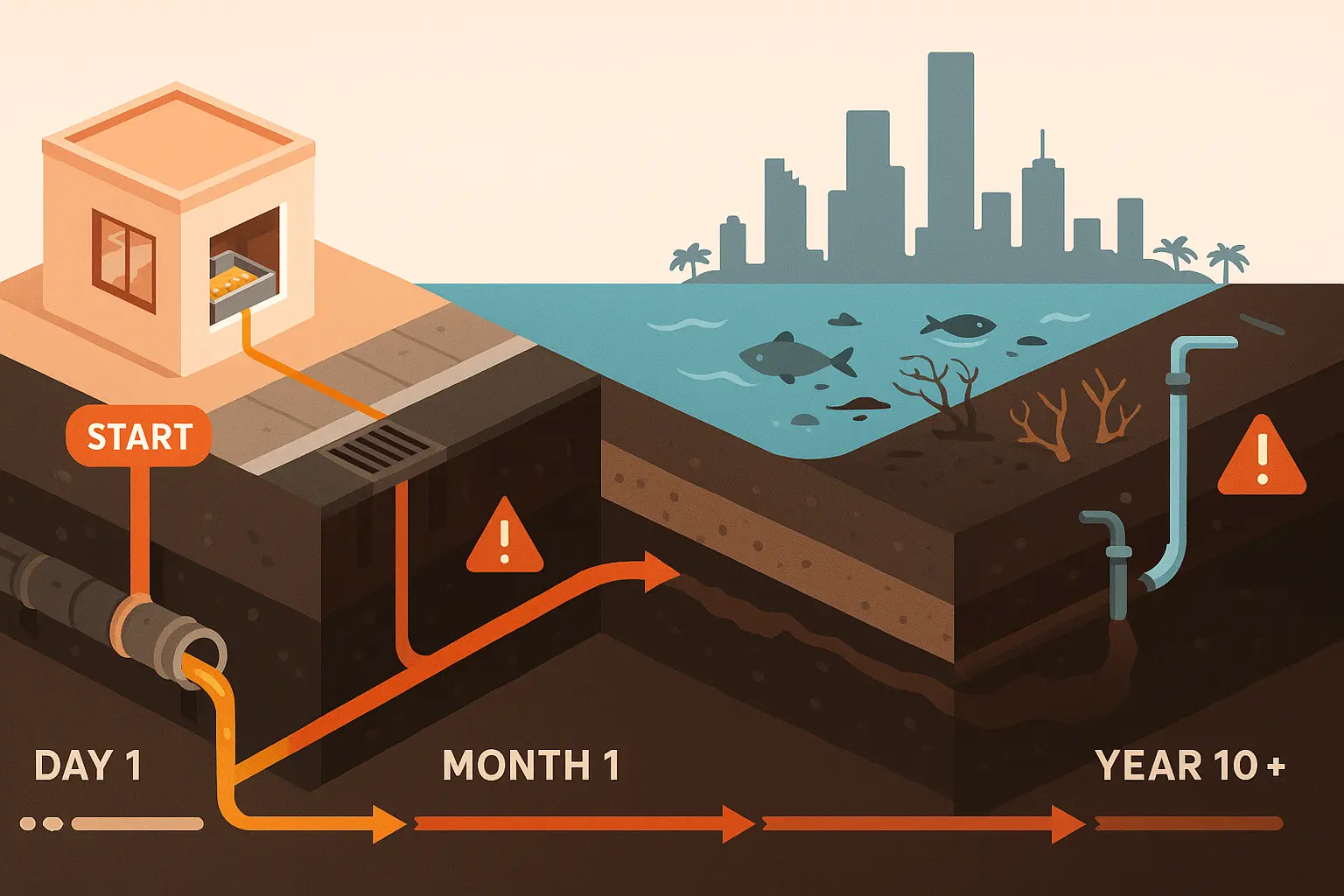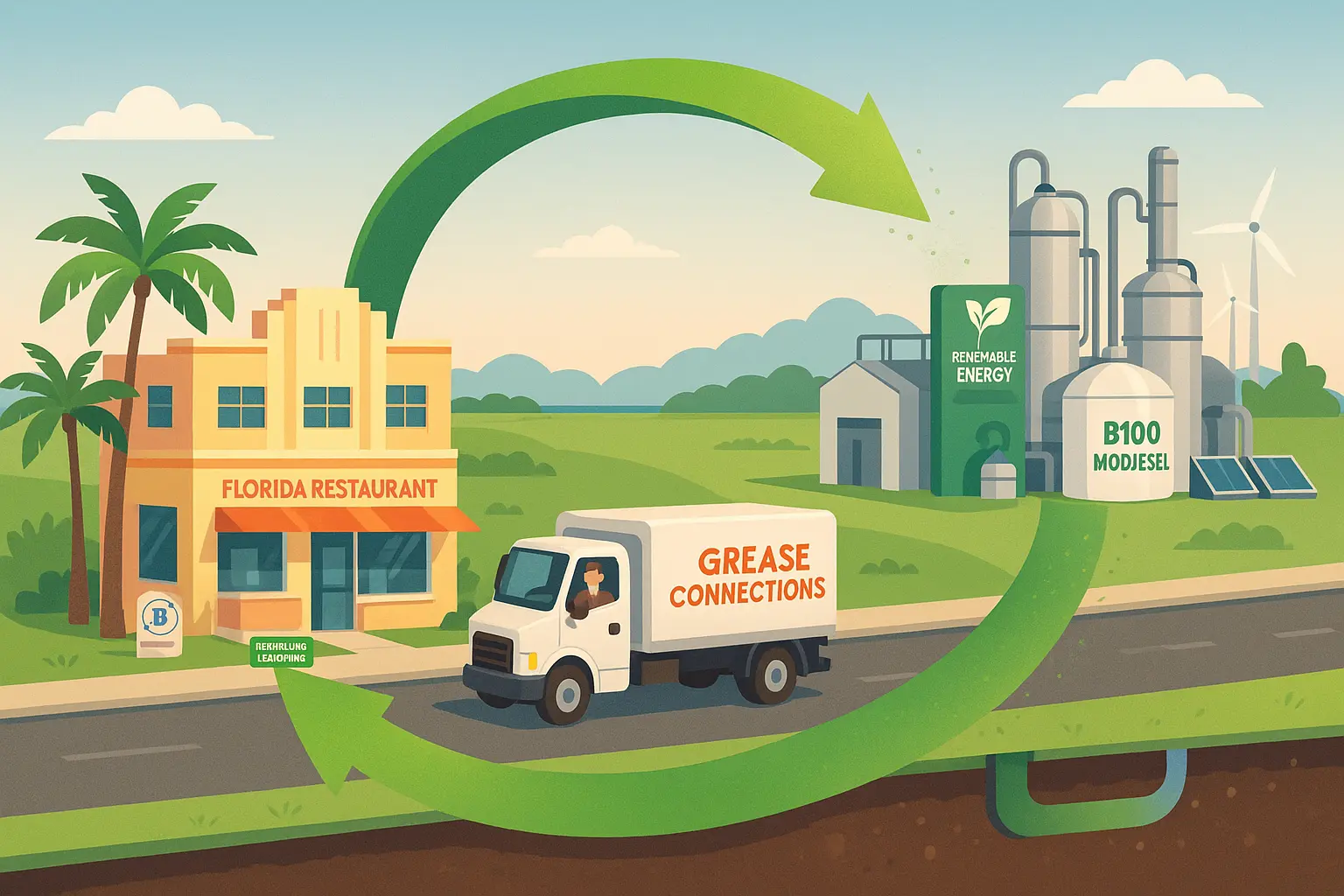Table of Contents
Understanding the Growing Concern
Used cooking oil has morphed from trash to treasure, leading to a rise in crime related to grease theft. Criminals, including organized gangs, target businesses for this valuable resource, causing significant financial and operational consequences.
Renewable biodiesel production needs a steady grease supply, and the price per gallon of waste oil now rivals low‑grade heating oil. That new value attracts both opportunists and organized gangs. Police say cooking‑oil theft accounts for up to one‑fifth of reclaimed oil in some UK regions, and similar trends ripple through U.S. cities. The increasing value of used cooking oil has created a lucrative black market primarily driven by its demand in renewable biodiesel production. The practice of converting used oil into unregulated biodiesel is becoming an increasingly common trend.
Why the Oil Gets Stolen
- Economic gain. The resale value is high enough to fund professional operations.
- Black‑market demand. Unregulated biodiesel plants pay cash, no paperwork, making stolen oil disappear into the supply chain, where it is often sold for profit. Stealing cooking oil is often profitable, with organized gangs targeting various establishments to sell it on the black market.
- Eco halo. Biodiesel is marketed as a fossil‑fuel alternative, so buyers rarely question provenance. Biodiesel, derived from used cooking oil, is promoted as an environmentally friendly alternative to diesel fuel, reducing reliance on fossil fuels.
- Low risk—until cameras roll. Few restaurateurs report minor grease theft, giving criminals room to scale.
How Theft Occurs
Most incidents follow a familiar script where thieves steal used cooking oil around 2 a.m., using rental trucks or vans to siphon oil. Two people pop the lid on an unsecured tank, drop a hose, and siphon hundreds of gallons in minutes. Many cooking oil thefts involve rental trucks or vans used to siphon oil. These vehicles are essential for thieves to access and transport the stolen oil.
They exit before dawn, selling the load to a middle‑man who blends it into unregulated biodiesel batches. Investigations show that video surveillance is crucial: high‑definition security cameras record license plates, vehicle color, and exact time, giving detectives what they need to trace the rental contract. Regular monitoring of oil levels and security footage can provide businesses with crucial insights and evidence to safeguard their valuable used cooking oil from thieves.
Spot the Vulnerable Spots
- Easy access gates. If someone can reach the drum without unlocking a gate, the site is an attractive target.
- Grease containers without locks. Flip‑top barrels or tote tanks are simple to breach, especially when grease is stored in secluded locations.
- Dark corners. Lack of security lighting lets thieves work unnoticed.
- Infrequent pickups. A full tank invites theft; an empty one deters thieves.
- Untrained night crew. Staff who assume anyone in a reflective vest is legitimate may wave criminals through, highlighting the need for effective deterrents.
Security Measures That Deter Thieves
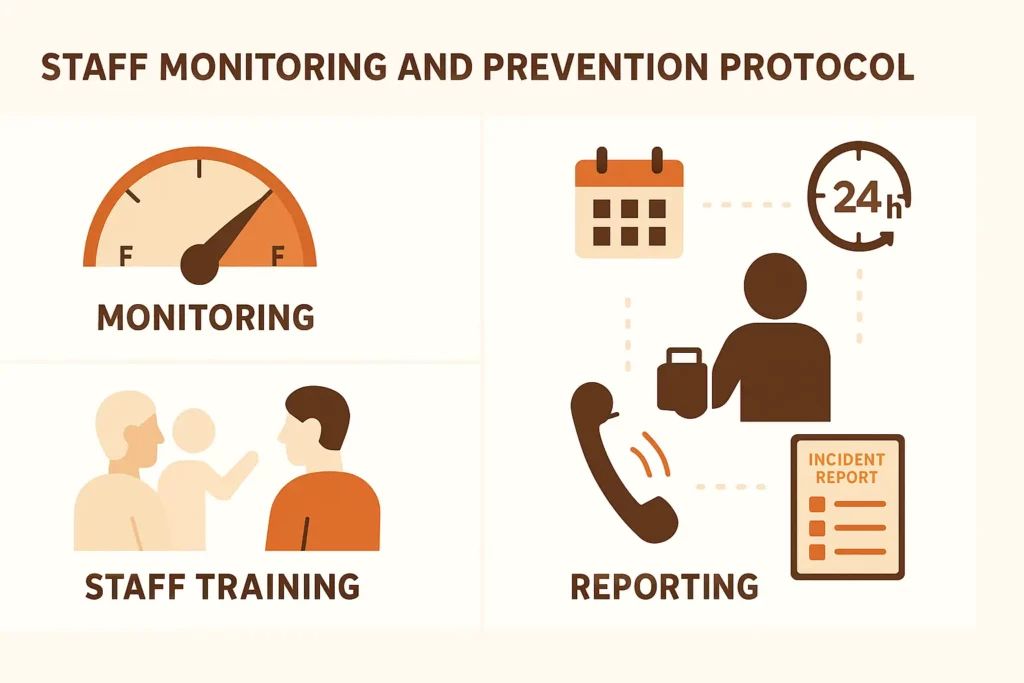
Secure Storage First
Upgrade to tamper‑proof containers with steel lids, padlock hasps, and internal anti‑siphon baffles. Position the tank inside a fenced corral where a thief would need bolt cutters and time—two deterrents. Proper disposal practices should also be followed to ensure that the used cooking oil is handled responsibly and to protect it from theft.
Illuminate the Alley
Install LED motion‑sensor lighting as an effective deterrent against theft. Bright light flips on the moment movement is detected, startling potential thieves and giving cameras a clear image. Remember: prevention beats chasing stolen goods.
Watch, Record, Report
Mount at least two surveillance cameras: one focused on the tank, the other on the driveway to capture arrival and departure. Monitoring through these cameras is essential to prevent cooking oil theft. Opt for units that record color video in low light. Installing high-definition security cameras can provide crucial footage of thefts, even in low light. Regularly export clips and store them off‑site; police need footage within 48 hours to investigate crimes effectively.
Train Your Team
Educating staff on preventative measures is the cheapest prevention tool. In a five‑minute line‑up, review the signs of used cooking‑oil theft: rental vans idling, strangers lifting container lids, slick spots on the ground. Teach employees to verify waste‑oil collectors by checking transporter IDs and manifests. Post a hotline number so suspicious activity reaches management fast.
Log Oil Levels Nightly
Create a habit of regularly checking oil levels at close as one of the effective ways to prevent theft. Note the gauge reading in your waste‑oil audit sheet. A sudden drop flags tampering; a swapped drum is obvious when the barcode doesn’t match yesterday’s log.
Keep Tanks Empty — or Close to It
Work with registered collection companies to pick up used cooking oils twice a week instead of once. Less product on site equals less temptation, and haulers often waive extra stops when volume is steady. Many jurisdictions require a registered waste carrier; using one avoids prosecution and ensures proper manifests. Many businesses must arrange for their used cooking oil to be taken away by a registered waste carrier to avoid prosecution under local laws.
Impact on Businesses
Thieves often target businesses with unsecured cooking‑oil storage, betting nobody will notice until the rebate cheque fails to arrive, highlighting the impact of criminal activity. Restaurants face significant challenges:
- Lost revenue. One 250‑gallon theft at two dollars a gallon erases $500. Repeat monthly and the figure tops $6,000. Financial losses result from cooking oil theft, affecting both restaurants and grease collection companies.
- Operational disruption. Broken valves spill grease, forcing fryer shutdowns and emergency clean‑ups. The theft of cooking oil can lead to operational disruptions, necessitating repairs and increased security measures.
- Legal penalties. Improper storage or spills can trigger fines and environmental‑impact fees.
- Insurance exposure. Claims may be denied if the insurer deems storage “negligent.”
The rising value of used cooking oil, repurposed into biodiesel or other industrial products, further incentivizes theft.
Building a Theft‑Proof Program
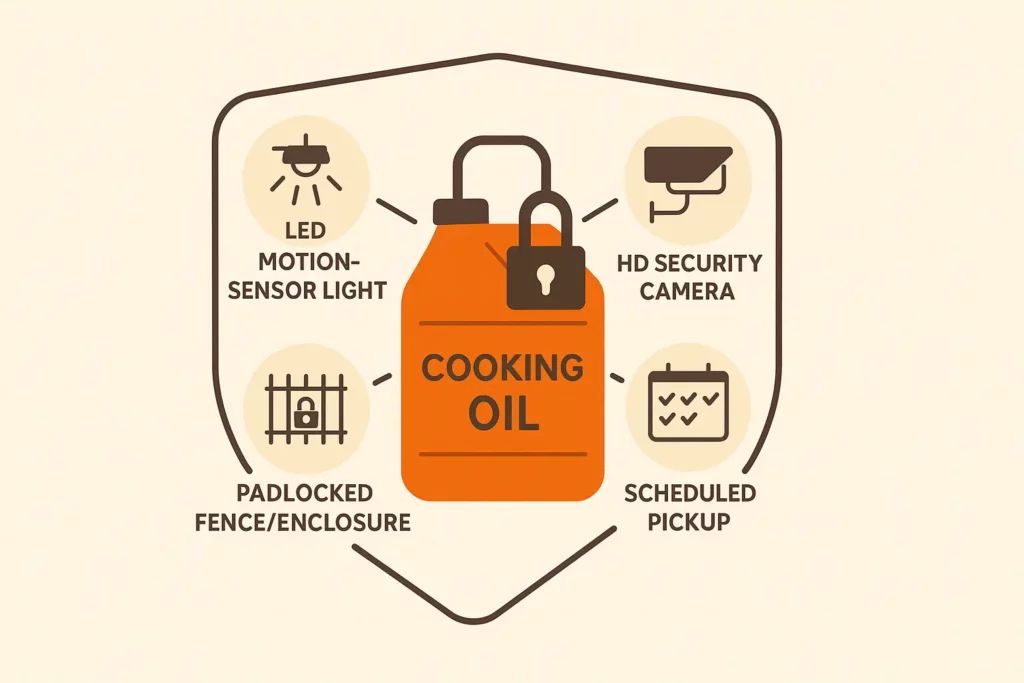
- Audit current defenses. Map gate locks, camera angles, and light coverage. Act immediately to identify and address any vulnerabilities.
- Upgrade weak links. Replace open barrels with lockable tanks; add motion lights. Implementing these deterrents can significantly reduce the risk of theft.
- Deploy technology. Use smart gauges that text alerts if levels drop unexpectedly.
- Schedule frequent pickups. Align hauler visits with peak production to keep inventory low. Establishing a regular collection schedule with waste oil services minimizes the opportunity for theft.
- Educate continuously. Quarterly refreshers keep oil‑theft prevention on every employee’s radar. Encourage staff to stay vigilant and report any suspicious activities.
- Report quickly. Call local law enforcement and share footage; timely reports help recover stolen goods and deter repeat offenders in your neighborhood.
- Implement proper waste management practices. Implementing proper waste management practices not only prevents theft but also reduces pollution and contributes positively to sustainability efforts.
Key Takeaways
Used cooking oil is now a lucrative target; the rise in its value in renewable fuel has unlocked a black market. Yet grease thieves are preventable. Combine secure storage, motion‑sensor lighting, HD cameras, nightly level checks, staff education, and prompt hauler pickups, and thieves will move on to easier prey.
Need lockable tanks, smart gauges, or a tighter pickup schedule? Grease Connections installs secure storage, LED floods, and 24‑hour pickups that keep your grease out of criminals’ hands and in your rebate column.

